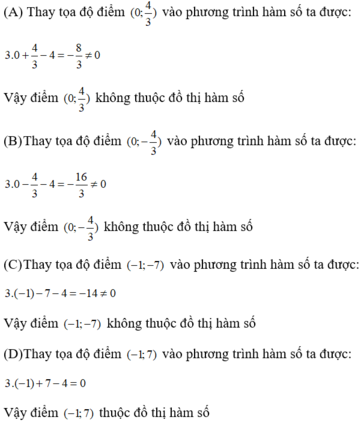Hãy nhập câu hỏi của bạn vào đây, nếu là tài khoản VIP, bạn sẽ được ưu tiên trả lời.

Thay tọa độ từng điểm vào phương trình đường thẳng ta thấy tọa độ điểm C thỏa mãn phương trình đường thẳng.
Chọn C (3 ; 3)

a: Đặt a=k; b=k'
=>(d): y=(a-3)x+b
Vì (d) đi qua A(1;2) và B(3;4) nên ta có hệ phương trình:
\(\left\{{}\begin{matrix}a-3+b=2\\3\left(a-3\right)+b=4\end{matrix}\right.\Leftrightarrow\left\{{}\begin{matrix}a+b=5\\3a+b=13\end{matrix}\right.\Leftrightarrow\left\{{}\begin{matrix}b=1\\a=4\end{matrix}\right.\)
b: (d): y=(a-3)x+b
Theo đề, ta có hệ phương trình:
\(\left\{{}\begin{matrix}b=1-\sqrt{2}\\\left(a-3\right)\cdot\left(1+\sqrt{2}\right)=\sqrt{2}-1\end{matrix}\right.\Leftrightarrow\left\{{}\begin{matrix}b=1-\sqrt{2}\\a=6-2\sqrt{2}\end{matrix}\right.\)
d: y-2x-1=0
nên y=2x+1(d1)
(d): y=(a-3)x+b
Để (d)//(d1) thì \(\left\{{}\begin{matrix}a-3=2\\b< >1\end{matrix}\right.\Leftrightarrow\left\{{}\begin{matrix}a=5\\b< >1\end{matrix}\right.\)

1.
\(a,\Leftrightarrow2m-1+m-2=6\Leftrightarrow3m=9\Leftrightarrow m=3\\ b,2x+3y-5=0\Leftrightarrow3y=-2x+5\Leftrightarrow y=-\dfrac{2}{3}x+\dfrac{5}{3}\)
Để \(\left(d\right)\text{//}y=-\dfrac{2}{3}x+\dfrac{5}{3}\Leftrightarrow\left\{{}\begin{matrix}2m-1=-\dfrac{2}{3}\\m-2\ne\dfrac{5}{3}\end{matrix}\right.\Leftrightarrow\left\{{}\begin{matrix}m=\dfrac{1}{6}\\m\ne\dfrac{11}{3}\end{matrix}\right.\Leftrightarrow m=\dfrac{1}{6}\)
\(c,x+2y+1=0\Leftrightarrow2y=-x-1\Leftrightarrow y=-\dfrac{1}{2}x-\dfrac{1}{2}\\ \left(d\right)\bot y=-\dfrac{1}{2}x-\dfrac{1}{2}\Leftrightarrow\left(-\dfrac{1}{2}\right)\left(2m-1\right)=-1\\ \Leftrightarrow\dfrac{1}{2}\left(2m-1\right)=1\Leftrightarrow m-\dfrac{1}{2}=1\Leftrightarrow m=\dfrac{3}{2}\)
2.
Gọi điểm cố định đó là \(A\left(x_0;y_0\right)\)
\(\Leftrightarrow y_0=\left(2m-1\right)x_0+m-2\\ \Leftrightarrow2mx_0+m-x_0-2-y_0=0\\ \Leftrightarrow m\left(2x_0+1\right)-\left(x_0+y_0+2\right)=0\\ \Leftrightarrow\left\{{}\begin{matrix}2x_0=-1\\x_0+y_0+2=0\end{matrix}\right.\Leftrightarrow\left\{{}\begin{matrix}x_0=-\dfrac{1}{2}\\y_0=-\dfrac{3}{2}\end{matrix}\right.\)

a: Theo đề, ta có hệ:
\(\left\{{}\begin{matrix}k-3+h=2\\-3k+9+h=4\end{matrix}\right.\Leftrightarrow\left\{{}\begin{matrix}k=\dfrac{5}{2}\\h=\dfrac{5}{2}\end{matrix}\right.\)
b: Theo đề, ta có hệ:
\(\left\{{}\begin{matrix}\left(k-3\right)\cdot0+h=1-\sqrt{2}\\\left(k-3\right)\cdot\left(1-\sqrt{2}\right)+h=0\end{matrix}\right.\Leftrightarrow\left\{{}\begin{matrix}h=1-\sqrt{2}\\\left(k-3\right)\cdot\left(1-\sqrt{2}\right)=-h=-\left(1-\sqrt{2}\right)\end{matrix}\right.\)
=>\(\Leftrightarrow\left\{{}\begin{matrix}h=1-\sqrt{2}\\k=2\end{matrix}\right.\)
c: 2y-4x+5=0
=>2y=4x-5
=>y=2x-5/2
Để hai đường cắt nhau thì k-3<>2
=>k<>5
d: y-2x-1=0
=>y=2x+1
Để hai đường song song thì k-3=2 và h<>1
=>k=5 và h<>1
e: 3x+y-5=0
=>y=-3x+5
Để hai đường trùng nhau thì k-3=-3 và h=5
=>k=0 và h=5

Đáp án là D